| Title The American Pika (Ochotona princeps) - The Life and Times of an Indicator Species | |
|
Author Dylan Kavanaugh American River College, Geography 350: Data Acquisition in GIS; Fall 2013 | |
|
Abstract This is a brief study into the species distribution of extirpated and extant American Pika's (Ochotona princeps) located in the California Sierra Nevadas and Nevada's Great Basin region of the Western United States and to determine if climate change has played a role in the distribution of this particular indicator species. | |
|
Introduction The American Pika (Ochotona princeps), a small rodent related to rabbits and hares, can be found found living in the high elevation talus sloped alpine regions of western North America. These mammals are extremely sensitive to warmer temperatures, and as a result of this, scientists have found that pikas can be very effective indicators of change in climate. So sensitive are they to heat, that if left in temperatures 77.9 degrees Fahrenheit or higher for more than six hours, they will die. Research has shown an increase in the number of pika communities abandoning lower elevations of their usual habitat for cooler regions higher up slope. Dramatic change to pika habitats in Nevada's Great Basin region is already being seen with extinction rates rapidly increasing and pikas steadily moving to higher elevations. The destruction of habitat threatens the ultimate survival to this species, and to the flora and fauna who coexist in this ecosystem. Not only may the future of the pika be in peril, but, potentially, so is the future for other species on the planet. If climate change is indeed contributing to a decline in these sensitive sentinels of the environment, it would be in our own best interest to heed their distress signals. |
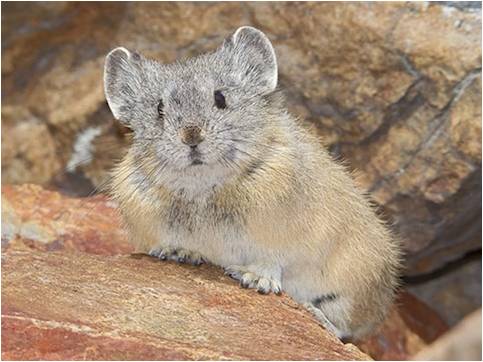
|
|
Background The American Pika (Ochotona princeps) is a member of the Order Lagamorpha, an Order to which hares and rabbits also belong. The range of the American Pika is distributed across a discontinuous geographic region in the mountainous terrain of Western North America, stretching from the southwestern United States, across the Great Plains, and up to the Canadian southwestern territories of Alberta and British Columbia (Smith and Weston 1990, Hafner and Smith 2010). The habitat of the Pika is typically high altitude talus sloped mountain ranges , where they make their home and shelter within and below the jagged field of broken rock (Smith and Weston 1990). The Pika seems to like talus areas where there exists RIF (rock-ice-features) - areas of "glacial- and/or periglacial-derived landforms primarilly occuring in high semi-arid temperate mountain ranges and arctic landscapes" (Millar and Westfall 2010). One study found that 83% of the 420 pika sites surveyed occured in RIF (Millar and Westfall 2010). Pikas tend to live near meadows and areas where vegetation such as grasses, thistle, and fireweed can be readily found and close enough for them to safely travel the short distance from their den in order to gather plants for immediate consumption and to add to the haypiles which are built throughout the warmer months in preparation for the upcoming cold winter (Smith and Weston 1990, Millar and Westfall 2010). Pika size can range anywhere from 162 to 216mm (6 - 8.5 inches) in length, generally weigh 121 to 176g (4.2 - 6.2 ounces), do not hibernate, and are diurnal (Smith 1978). They have a somewhat egg shaped body, small, round ears, short legs, and thick fur on the bottom of their feet (Smith and Weston 1990). Pikas have a high body temperature and are extremenly sensitive to warm temperatures in the surrounding environment, so sensitive are they that if temperatures reach 77 degrees Farehheit and they are unable to escape to a cooler climate between the talus (which is always much cooler than the environment above) pikas can die within six hours (Smith 1974). It is this behavioral and pysiological trait of the pika which makes them a important indicator species when it comes to studying climate change and global warming. | |
|
Methods Paleontological evidence from the Great Basin region indicates that during the late Wisconsinan ( c. 40,000 - 10,000 years ago) and the early Holocene ( c. 10,000 - 7,500 years ago) the average elevation for pika populations was 1750 meters. During the middle Holocene ( c. 7,500 - 4,500 years ago) which was a hot and dry period, Pika populations rose roughly 435 m (meters) to an elevation of 2,168 m (Grayson 2005). All of these prehistoric pika population sites are now extinct and have not been recolonized. Most of the prehistoric pika population sites known from the late Holcene ( c. 4,500 - 200 years ago) still show populations in existence, but colonies were lost during the historic period within these areas of the Great Basin and it has been shown that populations have climbed an additional 152 m in elevation (Grayson 2005). Pika distributions existing during the historic period are populations which had been established back in the Holocene, circa 4,500 years ago. The paleontological and archaeological records of the Great Basin prehistoric period tend to show low precipitation, higher temperatures, and the resulting changes to the local flora contributed to the prehistoric extinctions to pika populations (Grayson 1993). Dr. Erik A. Beever conducted pika surveys in the Great Basin region from 1994 - 1999 and found that seven out of twenty-five historical pika population sites he surveyed appeared to have become extinct over several decades. Dr. Beever's findings indicate that these historic extirpated pika sites in the Great Basin also endured low precipitation and higher temperatures (Beever et al., 2003, Grayson 2005). The twenty-five surveyed sites of the historical pika populations show an average minimum elevation of 2381 plus/minus 401 m. The remaining eighteen exant sites show a average minimum elevation of 2533 plus/minus 318 m, a difference of 152 m (Grayson 2005). Archaeological and paleontological analysis indicates that over the last 8,000 years, Great Basin pikas have abandoned lower elevations in favor of moving higher up the mountain to a cooler climate (Grayson 2005). Further research conducted in the California Sierra Nevadas, the western Great Basin of Nevada, and the Oregon Cascades has found pika populations unexpectedly existing in lower elevations then was previously known and documented greater distribution. Pika site elevations recorded in the Sierra Nevada and Great Basin ranged from 1827 m to 3887 m, with the average being 3038 m. The eight Oregon sites ranged from 1645 m to 2323 m. (Millar and Westfall 2010). It has been generally believed that pikas are not typically found below 2,500 m elevation within their southern most range in California (Smith and Weston 1990), yet many sites have been documented at lower elevations (Millar and Westfall 2010) and pika populations have even been found at 1,250 elevation (Ray and Beever 2007). So, a wide range of population elevations and thermal tolerances were found particularly in CA and NV. This research concluded that pika populations in the central Great Basin were were struggling more than other areas, but in the Sierra Nevada and southwestern Great Basin pikas were "thriving" (Millar and Westfall 2010). Over the last 30 years, temperatures in the western U.S. have risen 1 degree C (2 degree F), while pika temperature recording stations indicate a summer warming trend of 1 degree to 2.4 degree C (1.7 to 4.3 degree F) during the same time period (Ray et al 2010). Spring temperatures have become warmer, commencing 2 - 3 weeks sooner than usual, resulting in the melting of the winter snows ealier. This layer of winter snow acts as insulation for pikas living under the rock pilings, keeping them warm during the winter months (Ray et al 2010). Further studies on the central Great Basin pika community indicate extirpations of certain sites are due to "thermal stressors" rather than areas that experienced fluctuations in temperature, and these sites tended to have warmer summers and colder winters than sites where pikas remained PRISM spatial climate data suggest that sites where pikas remained tended to have higher precipitation rates (Beever et al 2010, Beever et al 2011). Also noted within this area was that lower latitudes tended to support a lesser number of pikas. Climate models projecting future climate trends through 2100, all seemingly indicated universal increases in temperatures . For the western United States temperatures will rise more here than in other areas of North America, with the models predicting summers will increase by 2.75 degrees C (5 degrees F, estimates ranging from 1.65 to 3.85 degrees C, 3 to 7 degress F) (Ray et al 2010). Winter is projected to increase by 1.65 degrees C (3 degree F) (Ray et al 2010). Projected temperature increases will adversely effect snowpacks at lower elevations (under 2,500 m/8,500 ft). In response to the 1 degree C rise in temperature over the last 30 years, the U.S. Climate Change Science Program (CCSP) states that "human induced warming has likely caused much of the average temperature increase in North American over the last 50 years" (CCSP SAP 3.3, p.3). They go on to say "and it is likely that greenhouse gases produced from human activities alone caused much of this increase" (CCSP SAP 3.3 2008). | |
|
Figures and Maps | |
|
NOAA Historical CO2 Recordings |
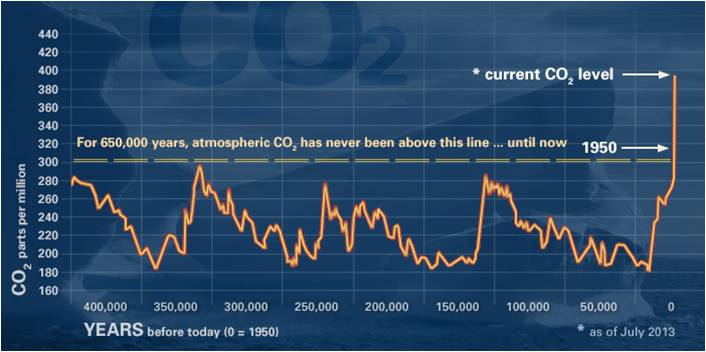
|
|
Pika Distributions in western North America |
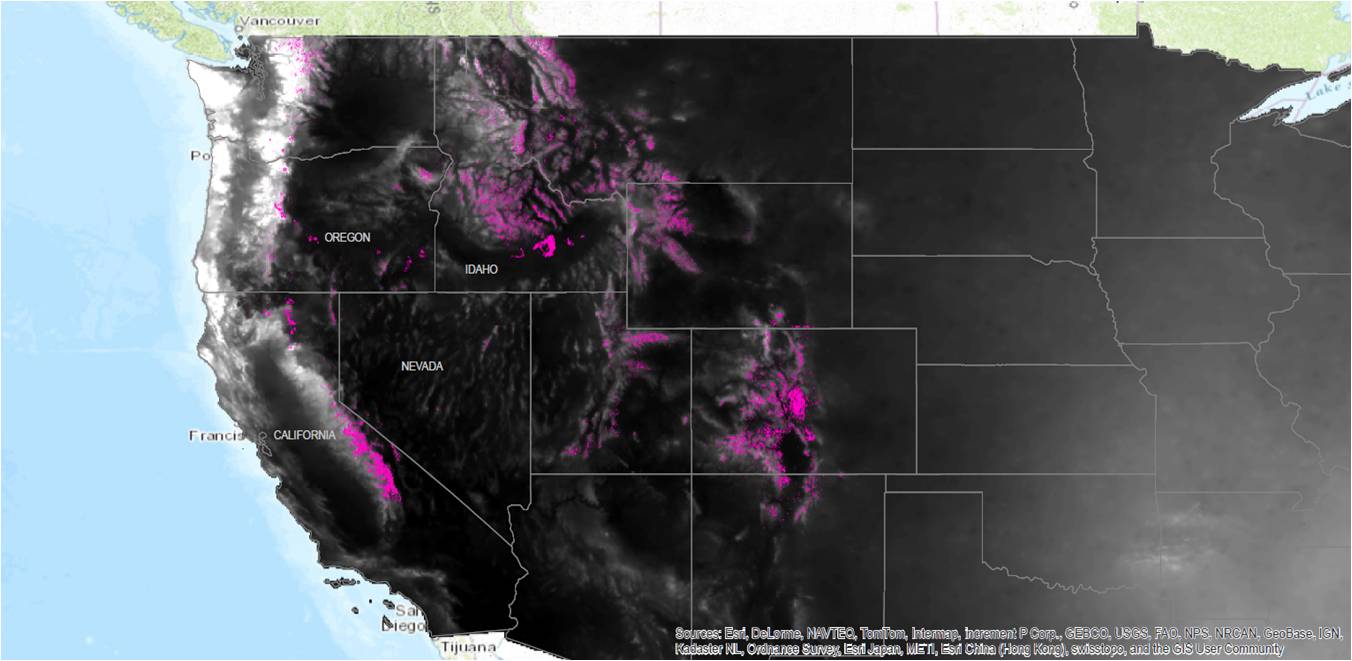
|
|
Pika observation sites in western North America |
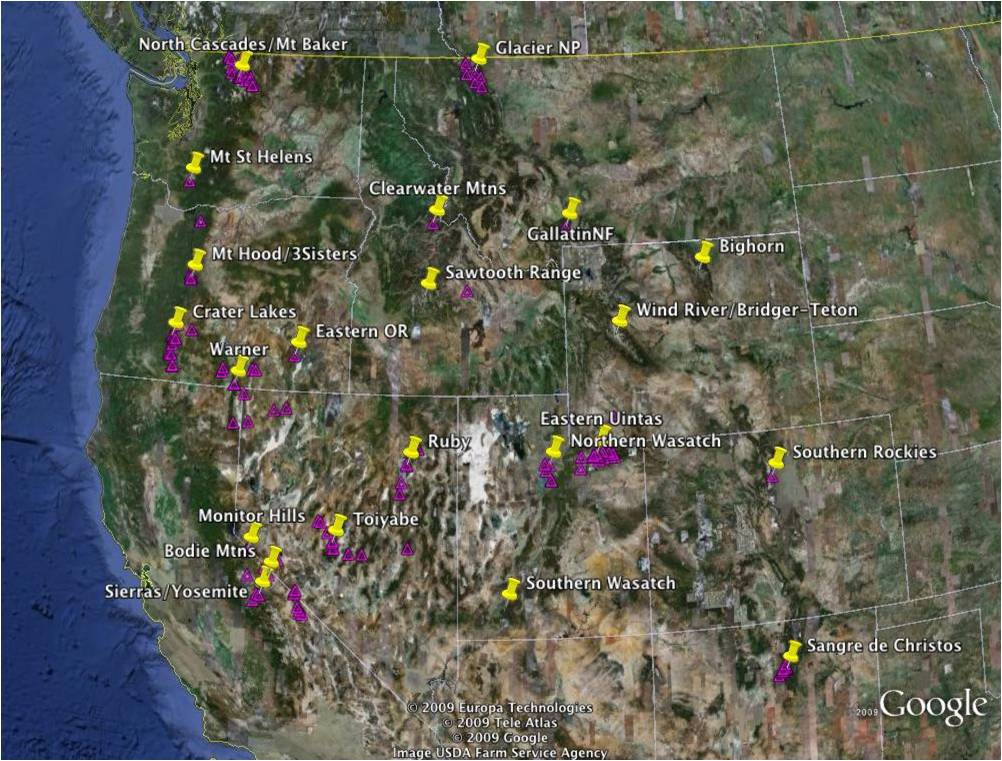
|
|
Study sites within the hydrologic Great Basin, with reference to sites of prehistoric extirpation of the
American pika. Blue and white pixels denote areas >2286 m in elevation. The area of the minimum convex
polygon encompassing all study sites = 38.2 million ha. Note that extirpations reflect lack of occupancy at the site level across multiple surveys, but do not necessarily reflect loss of the species from the entire mountain range. Archeological sites outside the hydro graphic Great Basin represent
only a small subset of all type of O. princeps localities know from outside the Basin (Beever et al., 2011)
|
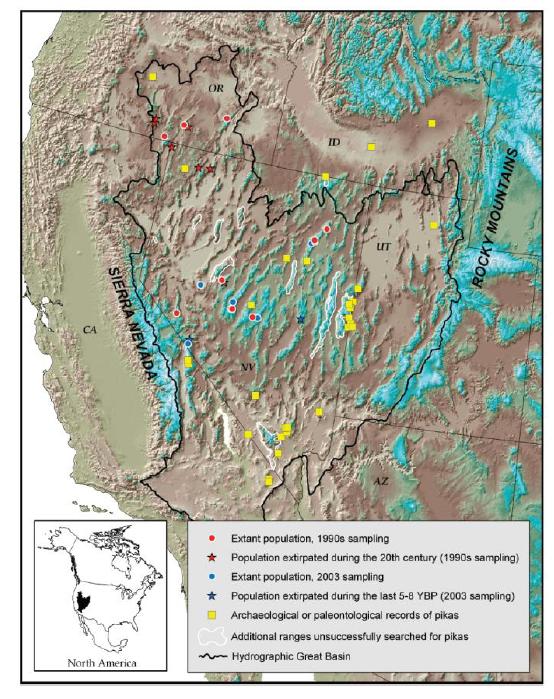
|
|
Combined inductive and appropriate habitat filter models of current predicted suitable habitat
for O princeps (A); suitable habitat under a 1 - 7 degree C increase in temperature of the warmest quarter of
the year (B through H respectively) (Calkins et al., 2012) |

|
|
The 1950 - 2007 trend in observed annual average North American surface temperature in Celsius degrees.
(Ray et al., 2008) |

|
|
Analysis The success of this project was expanding my knowledge on a specific species, the American pika, and learning more about all of the research on climate change and just how much information, data, conjecture, postulation, and projection modeling there is out there in the world. Never having done any extensive research into climate change, climate projection and modeling,I actually found it to be quite overwhelming at times in trying to figure out what data to include, and what data is pertinent to what I was trying to accomplish. I did find a lot of research papers and web sites dedicated to the pika, but did not always find perhaps the exact data sets I was hoping to use. In hindsight, perhaps I should have gone about my intitial research and data collecting differently. I originally had wanted to do some species distribution modeling, but was not successful because I think the learning curve for that was something I needed to spend more time working through. Same thing with various statistical and climate modeling programs - more expertise and time were required then I was able to donate at the time. I ultimately learned a lot on a variety of topics, while at the same time becoming aware of how much I did not know.... | |
|
Conclusions From what I have gathered through my research, the majority of scientists and researchers who study climate change agree that changes to global climate are occuring, have been occuring for many decades now, and will continue to occur - and is most likely due to the negative effect of human behaviors. I also found that there still is much to be learned about the pika, their population numbers, range and distribution, and exactly how changes in climate are impacting their colonies. One thing I consistenly encountered in regards to pika research is that there is still much that is unclear and not known at this time. Due to the pika being an environmental indicator species, the proverbial canary in a mineshaft, research into this small mammal has been increasing over the years. Our pika knowledge base has expanded, but this little critter is not so readily giving up all of their secrets. Much more data collection and long term observations are required to fully understand pika behavior and interactions with the environment. | |
|
References
Beever, E.A., Brussard, P.F. & Berger, J.(2003). Patterns of apparent extinction among isolated populations of pikas (Ochotona princeps) in the Great Basin. Journal of Mammology, 84, 37 - 54. Calkins, M.T., Beever, E.A., Boykin, K.G., Frey, J.K., & Andersen, M.C. (2012). Not-so-splendid isolation: modeling climate- mediated range collapse of a montane mammal Ochotona princeps across numerous ecoregions. Ecography, 35, 780 - 791. Grayson, D.K. (1993). The desert's past: a natural prehistory of the Great Basin. Smithsonian Institute Press, Washington, D.C. Grayson, D.K. (2005). A brief history of Great Basin Pikas. Journal of Biogeography, 32, 2103 - 2111. Hafner, D.J. & Smith A.T. (2010). Revision of the subspecies of the American pika, Ochotona princeps (Lagamorpha: Ochotonidae). Journal of Mammalogy, 91, 401 - 417. Ray, A., Barsugli, K.W. & Eischeid, J.(2010). NOAA Rapid-Response Climate Assessment to Inform the FWS Status Review of the American Pika. fs.fed.us. Smith A.T. (1978). Comparative demography of pikas (Ochotona): effect of spatial and temporal age-specific mortality. Ecology 59, 133 - 139. Millar, C.I.& Westfall, R.D. (2010). Distribution and climatic relationships of the American pika (Ochotona princeps) in the Sierra Nevada and western Great Basin, USA: Periglacial landforms as refugia in warming climates. Arctic, Antarctic and Alpine Research 42, 76 - 88. | |
|
Appendices Material may be included in various appendix sections at the studentís option. | |